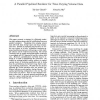Free Online Productivity Tools
i2Speak
i2Symbol
i2OCR
iTex2Img
iWeb2Print
iWeb2Shot
i2Type
iPdf2Split
iPdf2Merge
i2Bopomofo
i2Arabic
i2Style
i2Image
i2PDF
iLatex2Rtf
Sci2ools
ISPAN
1997
IEEE
1997
IEEE
A Parallel Pipelined Renderer for Time-Varying Volume Data
This paper presents a strategy for efficiently rendering time-varying volume data on a distributed-memory parallel computer. Visualizing time-varying volume data take both large storage space and long computation time. Instead of employing all processors to render one volume at a time, a pipelined rendering approach partitions processors into groups so that multiple volumes can be rendered concurrently. The overall rendering time is greatly minimized because rendering is overlapped with 1/0 required to load the volume data sets. Moreover, parallelization overhead may be reduced as a result of partitioning the processors. We modify an existing parallel volume renderer to exploit various levels of rendering parallelism and to study how the partitioning of processors may lead to optimal rendering performance. We find that two factors affecting the overall ezecution time are resource utilization efficiency and pipeline startup latency. The optimal partitioning configuration is the one tha...
Distributed And Parallel Computing | ISPAN 1997 | Overall Rendering Time | Pipelined Rendering Approach | Time-varying Volume Data |
| Added | 06 Aug 2010 |
| Updated | 06 Aug 2010 |
| Type | Conference |
| Year | 1997 |
| Where | ISPAN |
| Authors | Tzi-cker Chiueh, Kwan-Liu Ma |
Comments (0)

